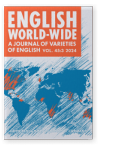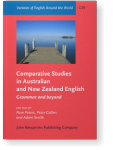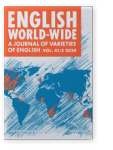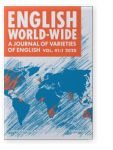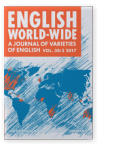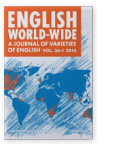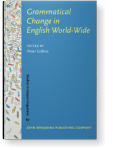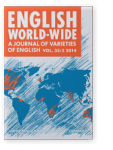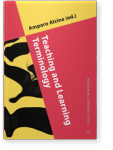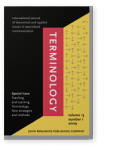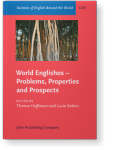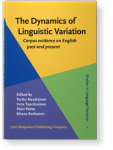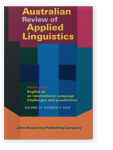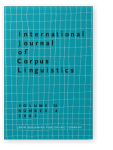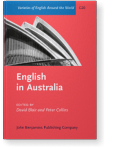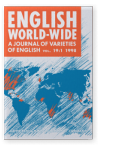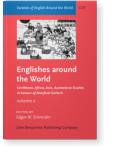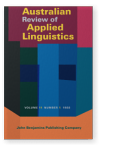Pam Peters
List of John Benjamins publications for which Pam Peters plays a role.
Journal
Title
Comparative Studies in Australian and New Zealand English: Grammar and beyond
Edited by Pam Peters, Peter Collins and Adam Smith
[Varieties of English Around the World, G39] 2009. x, 406 pp.
Subjects Comparative linguistics | English linguistics | Sociolinguistics and Dialectology | Syntax | Theoretical linguistics
2020 Code-switching in online academic discourse: Resources for Philippine English English World-Wide 41:2, pp. 131–161 | Article
World Englishes are the product of contact between English and other languages in multilingual habitats through the nativization phase. Yet the actual contexts of code-switching that contribute to the emerging regional variety have scarcely been described. This research focuses on code-switching… read more
2015 Response to Davies and Fuchs English World-Wide 36:1, pp. 41–44 | Commentary
Commentary to: Davies, Mark, and Robert Fuchs. 2015. "Expanding horizons in the study of World Englishes with the 1.9 billion word Global Web-based English Corpus (GloWbE)". English World-Wide 36:1–28 (This issue). DOI:10.1075/eww.36.1.01dav
read more2015 Dual adverbs in Australian English Grammatical Change in English World-Wide, Collins, Peter (ed.), pp. 179–204 | Article
Dual or dual-form adverbs are those found with and without the -ly suffix in modern English (e.g. deep/deeply), providing alternative forms for adverbial constituents or modifiers within the clause. But research on British English has shown decreasing numbers of fully interchangeable pairs. This… read more
2014 Differentiation in Australian English The Evolution of Englishes: The Dynamic Model and beyond, Buschfeld, Sarah, Thomas Hoffmann, Magnus Huber and Alexander Kautzsch (eds.), pp. 107–125 | Article
The Differentiation Phase (Phase 5 of Schneider’s Dynamic Model) has so far been reached by only a handful of settler Englishes: American English, Australian English, Canadian English, New Zealand English, with internal diversification as well as unique admixtures of indigenized and adstrate… read more
2011 Terminology and terminography for architecture and building construction Teaching and Learning Terminology: New strategies and methods, Alcina, Amparo (ed.), pp. 11–35 | Article
2009 Terminology and terminography for architecture and building construction Teaching and Learning Terminology: New strategies and methods, Alcina, Amparo (ed.), pp. 10–36 | Article
Teaching terminology is a strategic response to the European Educational Convergence guidelines, taken by the Polytechnic University of Madrid. It is vested in a new course “English Terminology for Architecture and Building Construction” offered in the “Master of Techniques and Systems of… read more
2009 Australian English as a regional epicenter World Englishes – Problems, Properties and Prospects: Selected papers from the 13th IAWE conference, Hoffmann, Thomas and Lucia Siebers (eds.), pp. 107–124 | Article
This paper explores whether an evolving regional standard of English could impact on the development of neighboring varieties while still consolidating its own identity. In the case of Australian English this can be seen in several kinds of lexical innovation, which are uniquely or strongly… read more
2009 The mandative subjunctive in spoken English Comparative Studies in Australian and New Zealand English: Grammar and beyond, Peters, Pam, Peter Collins and Adam Smith (eds.), pp. 125–138 | Article
Regional variation of the mandative subjunctive has come to light during the twentieth century, with corpus-based research showing it to be standard usage in American English whereas its currency in British English was limited. This research reviews the use of the mandative in spoken data from six… read more
2009 Irregular verbs: Regularization and ongoing variability Comparative Studies in Australian and New Zealand English: Grammar and beyond, Peters, Pam, Peter Collins and Adam Smith (eds.), pp. 13–30 | Article
Both language history and mathematical modeling suggest that the English irregular verbs will generally evolve to become more regular. Yet closer investigation of individual verbs and verb groups shows that evolutionary expectations can be overstated. Data from the ICE-corpora for Australian, New… read more
2009 Epilogue Comparative Studies in Australian and New Zealand English: Grammar and beyond, Peters, Pam, Peter Collins and Adam Smith (eds.), pp. 387–400 | Article
2009 No in the lexicogrammar of English Comparative Studies in Australian and New Zealand English: Grammar and beyond, Peters, Pam, Peter Collins and Adam Smith (eds.), pp. 225–242 | Article
This paper analyzes the continuing uses of no in negative collocations in three varieties of English: Australian, New Zealand and British, using their respective ICE corpora. In all three varieties of English, the use of no as determiner in nominal phrase collocations far outnumbers its use in… read more
2008 Patterns of negation: The relationship between NO and NOT in regional varieties of English The Dynamics of Linguistic Variation: Corpus evidence on English past and present, Nevalainen, Terttu, Irma Taavitsainen, Päivi Pahta and Minna Korhonen (eds.), pp. 147–162 | Article
The choice between NO and NOT in the expression of the negative in English has been found to vary with lexical, syntagmatic, and contextual factors such as medium, register and regional variety. This paper uses matching data from British, American, Australian and New Zealand corpora, in order to… read more
2008 International English and its construction English as an International Language: Challenges and possibilities, Clyne, Michael and Farzad Sharifian † (eds.), pp. 35.1–35.10 | Miscellaneous
2007 A study of backchannels in regional varieties of English, using corpus mark-up as the means of identification International Journal of Corpus Linguistics 12:4, pp. 479–510 | Article
Backchannels are a linguistic phenomenon that remains poorly defined. Borrowing of terminology and a reliance on axiomatic definitions has resulted in a diverse nomenclature and an indeterminate inventory of forms. Further, research concentration on backchannels produced in northern hemisphere… read more
2001 Corpus evidence on Australian style and usage English in Australia, Blair, David and Peter Collins (eds.), pp. 163–178 | Article
1998 The Survival of the Subjunctive: Evidence of its use in Australia and Elsewhere English World-Wide 19:1, pp. 87–103 | Article
The status of the subjunctive is examined in this Australian study of its manifestations in subordinate clauses: in mandative constructions as well as those expressing purpose, condition, concession and the counterfactual. Data from the Australian ACE corpus (1986) is compared with (a) those from… read more
1997 Fowler’s legacy Englishes around the World: Studies in honour of Manfred Görlach, Schneider, Edgar W. (ed.), pp. 301–318 | Article
1988 The Australian corpus project: Findings on the distribution of some functional variants in the Australian press Australian Review of Applied Linguistics 11:1, pp. 22–33 | Article
The functional variants of International English are often differently distributed in the different regional standards. With evidence from the corpus of Australian English, this has already been shown for lexical variants such as will/shall, maybe/perhaps etc. In this paper evidence from the… read more
